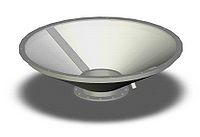Difference between revisions of "Aerated Bottoms"
(Created page with "Category:Discharge Aids{{Knoppen}} <noinclude><!------------------------------------------------ * READ THIS FIRST * Only edit this page if you can improve the content. ...") |
PurplePen19 (talk | contribs) |
||
| Line 6: | Line 6: | ||
* Please start editing this page after the /noinclude | * Please start editing this page after the /noinclude | ||
* -------------------------------------------------></noinclude> | * -------------------------------------------------></noinclude> | ||
[[File:Aerated bottoms.jpg|thumb|200px|right|Aerated bottoms]] | |||
'''Aerated bottoms''' are used to promote consistent product withdrawal from large-diameter flat- or conical-bottom storage silos. It does this by passing low-pressure air through a porous membrane media and into the bed of the material being handled. The low-pressure air is then passed up through the material in the silo, giving it a highly fluid property. | |||
You can handle a large variety of materials with aeration conveyors. The criteria are particle size, moisture content and temperature. Generally a product should have a particle distribution of 100% through a 20 mesh screen. Moisture content should be below 1% and temperature can not exceed 1200 degrees Fahrenheit [649˚ C]. | |||
The absence of moving parts and low power requirements make air gravity conveying the most economical means to convey fine materials over short or long distances. | |||
==Applications== | |||
*Truck Loadout | |||
*Truck and Railcar Loadout | |||
*Live Bottom Dome and Silo Storage | |||
*Ship and Barge Loading | |||
*Stockpiling | |||
*Bag and Drum Filling | |||
Latest revision as of 04:10, 14 September 2012
Aerated bottoms are used to promote consistent product withdrawal from large-diameter flat- or conical-bottom storage silos. It does this by passing low-pressure air through a porous membrane media and into the bed of the material being handled. The low-pressure air is then passed up through the material in the silo, giving it a highly fluid property. You can handle a large variety of materials with aeration conveyors. The criteria are particle size, moisture content and temperature. Generally a product should have a particle distribution of 100% through a 20 mesh screen. Moisture content should be below 1% and temperature can not exceed 1200 degrees Fahrenheit [649˚ C]. The absence of moving parts and low power requirements make air gravity conveying the most economical means to convey fine materials over short or long distances.
Applications
- Truck Loadout
- Truck and Railcar Loadout
- Live Bottom Dome and Silo Storage
- Ship and Barge Loading
- Stockpiling
- Bag and Drum Filling
